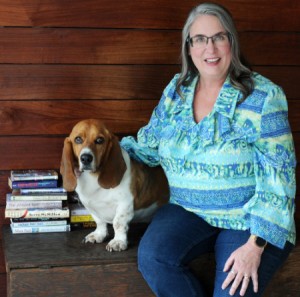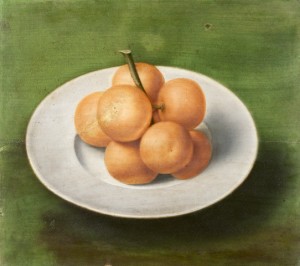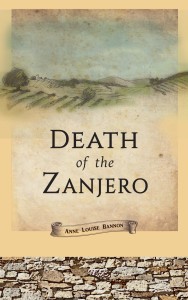 Relevant History welcomes back Anne Louise Bannon, who wrote her first novel at age fifteen. Her journalistic work has appeared in Ladies’ Home Journal, The Los Angeles Times, Wines and Vines, and in newspapers across the country. She created the OddBallGrape.com wine education blog with her husband, Michael Holland, and is the co-author of Howdunit: Book of Poisons, with Serita Stevens, as well as author of the “Freddie and Kathy” mystery series, set in the 1920s, and the “Operation Quickline” series and Tyger, Tyger. She and her husband live in Southern California with an assortment of critters. For more information about her and her books, visit her web site, and follow her on Facebook and Twitter.
Relevant History welcomes back Anne Louise Bannon, who wrote her first novel at age fifteen. Her journalistic work has appeared in Ladies’ Home Journal, The Los Angeles Times, Wines and Vines, and in newspapers across the country. She created the OddBallGrape.com wine education blog with her husband, Michael Holland, and is the co-author of Howdunit: Book of Poisons, with Serita Stevens, as well as author of the “Freddie and Kathy” mystery series, set in the 1920s, and the “Operation Quickline” series and Tyger, Tyger. She and her husband live in Southern California with an assortment of critters. For more information about her and her books, visit her web site, and follow her on Facebook and Twitter.
*****
The fun thing about my latest novel, Death of the Zanjero, is that it really couldn’t take place anywhere but in Los Angeles, California, or at any time but in the 19th century. Okay, I could have pushed it to the early 20th century, but by then, the odds were not good that the body of the Zanjero (or water overseer) would come floating up as the sluice gate opened to a rancho’s zanja (irrigation ditch). Lots of places, even as far away as New Mexico, had zanjas for irrigation and zanjeros overseeing them. But they didn’t have the wine industry that Los Angeles did—one that predates wineries in Livermore and the Napa Valley.
 Yes, you read that right. California’s wine industry actually began in Los Angeles. There were older vineyards in Arizona and other Spanish outposts. That’s because they needed wine to celebrate Mass, and making your own was somewhat easier than importing it from Spain. And, in the late 18th century, when Father Junipero Serra and company started trekking up Alta California, leaving the twenty-one missions behind, it only made sense to plant olives and grapes.
Yes, you read that right. California’s wine industry actually began in Los Angeles. There were older vineyards in Arizona and other Spanish outposts. That’s because they needed wine to celebrate Mass, and making your own was somewhat easier than importing it from Spain. And, in the late 18th century, when Father Junipero Serra and company started trekking up Alta California, leaving the twenty-one missions behind, it only made sense to plant olives and grapes.
Spanish wines
I have heard it said that the reason the padres mostly planted a supposedly inferior variety that we know today as the mission grape was that the government in Spain didn’t want New World wines competing with theirs. That does not entirely make sense to me, but the mission grape was certainly plentiful, and the padres used it to make a fortified wine that resembled Jerez, or sherry. The version they made in what became Los Angeles was one they called angelica.
Now, Los Angeles was founded in 1781, and that’s presumably when the first vineyards were planted. But what really got the industry part of the pueblo going is when the appropriately-named Jean Louis Vignes, a Frenchman, first brought French varieties, such as cabernet sauvignon and others, and decided that an area just to the west of the river (now downtown Los Angeles) would be perfect for growing them. He later sold his business to his nephews, the Sainsevain brothers. Another man, Matthew Keller, planted out a good bit of what is now Malibu. By the 1840s, San Francisco and Napa were importing grapes and wines from Los Angeles. Not much changed when the Americans took over in 1850 and California became a U.S. state.
How this affects my novel
I ended up setting Death of the Zanjero in 1870 because I did not want to deal with the Civil War (although the city remained a hotbed of Confederate sympathizers). I chose winemaking as a profession for my main character, Maddie Wilcox, because my husband and I are passionate about wine and we both found the wine history of our local area fascinating. Around that time, about 3,000 acres were planted with vineyards, and upwards of 5,000 acres, if you count the Anaheim Colony, which was part of Los Angeles County at the time and later became Orange County.
It wasn’t the biggest crop by any means. In 1880, there were 10,000 acres of the notoriously hard to grow wheat across the county, 60,000 acres of corn, and 90,000 acres of barley. Oranges, which were to play a much larger role in how our community grew, were there, but not in any significant force. According to the same 1880 history of the county that I got the above numbers from, there were around 34,000 oranges trees in all of the county, with roughly 200 trees per acre, that makes 170 acres of what would become our signature crop.
The end of the vineyards
 So, what happened? The railroads. In the middle of the 1870s, Henry Huntington and his pals started building steam engine railroads that connected Los Angeles to the rest of the country. This did two things. One, it opened up the market for oranges because you could finally ship them cross-country to the more heavily populated east before the fruit spoiled. Two, it brought people to Los Angeles. In 1870, there were roughly 5,700 people in the city of Los Angeles. In 1880, the town’s population doubled and grew at an even faster rate until by 1920, it had increased tenfold to 577,000. That’s only fifty years.
So, what happened? The railroads. In the middle of the 1870s, Henry Huntington and his pals started building steam engine railroads that connected Los Angeles to the rest of the country. This did two things. One, it opened up the market for oranges because you could finally ship them cross-country to the more heavily populated east before the fruit spoiled. Two, it brought people to Los Angeles. In 1870, there were roughly 5,700 people in the city of Los Angeles. In 1880, the town’s population doubled and grew at an even faster rate until by 1920, it had increased tenfold to 577,000. That’s only fifty years.
Also, in the mid-1870s, over-production caused the price of grapes to bottom out, and then the area was hit with Pierce’s Disease, which thrashed a goodly chunk of the vines. With people moving in, land became more valuable for housing than grapes. Oranges were still relatively hard to get in other parts of the country because they couldn’t be grown just anywhere, so that made them more valuable to plant. Wine grapes, not so much.
There are still wineries in Los Angeles. In fact, one of the state’s oldest, continuously running wineries, San Antonio Winery, is based here. Malibu has its own American Viticulture Area designation for its vineyards and several wineries, although that’s a very recent thing, and none of the old vineyards exist. There are even more wineries moving into the area. It’s a nice return to a formerly proud tradition—and one that made that a very fun background for a novel about a corrupt official getting murdered and the widow who finds herself trying to find whodunit.
*****
 A big thanks to Anne Louise Bannon. She’ll give away a paperback or ebook copy of Death of the Zanjero to someone who contributes a comment on my blog this week. I’ll choose the winner from among those who comment by Friday at 6 p.m. ET. Delivery of the ebook is available worldwide. Delivery of the paperback is available within the U.S. only. Special option for a U.S. winner: In lieu of a book, and if you qualify age- and state-wise, Anne will send you a half-bottle of angelica, a delightful sherry-style wine, made from possibly the oldest vines in the state of California.
A big thanks to Anne Louise Bannon. She’ll give away a paperback or ebook copy of Death of the Zanjero to someone who contributes a comment on my blog this week. I’ll choose the winner from among those who comment by Friday at 6 p.m. ET. Delivery of the ebook is available worldwide. Delivery of the paperback is available within the U.S. only. Special option for a U.S. winner: In lieu of a book, and if you qualify age- and state-wise, Anne will send you a half-bottle of angelica, a delightful sherry-style wine, made from possibly the oldest vines in the state of California.
**********
Did you like what you read? Learn about downloads, discounts, and special offers from Relevant History authors and Suzanne Adair. Subscribe to Suzanne’s free newsletter.
